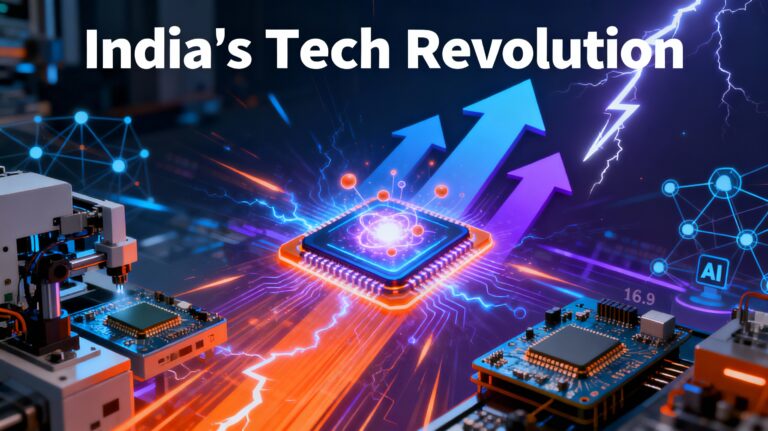Key Highlights:
- Hawk Eye technology demonstrated at China’s 15th National Games achieves precision within 3.6 millimeters and 99% accuracy through high-speed cameras (up to 10-40 cameras depending on sport), triangulation algorithms, and real-time ball tracking, eliminating disputed officiating decisions.
- The system operates globally across 45,000+ matches annually covering cricket (1,000+ match days), tennis (10,000+ court days across 100+ events), football/VAR (400+ stadiums, 95+ countries), rugby, basketball, badminton, and table tennis—with demonstrable impact reducing errors from 95% to 99.3% accuracy.
- India’s BCCI introduced Smart Replay System for IPL 2024 using Hawk Eye operators in same room as TV umpire with split-screen analysis, while V6 Sports developed certified indigenous DRS system deployed across 700+ official matches with instant no-ball detection, sound sense technology, and 3D ball trajectory analysis.
- Sports officiating controversies continue constraining Indian sports: wrestling governance gaps, football federation governance issues, cricket match-fixing scandals, table tennis federation controversies, and kabaddi/traditional sports lacking standardized officiating infrastructure despite rapid professionalization.
- China’s smart officiating deployment at National Games signals strategic sports technology sovereignty and credibility-building for mega-event hosting, offering India critical lessons: indigenous solutions reduce import dependency, standardize decisions across sports, and build public trust essential for hosting credible international competitions.
Imagine a moment frozen in time: a cricket catch so close to the boundary that 50,000 spectators, the fielder, the batsman, and the umpire all see something different. In traditional officiating, the umpire’s call stands. But with Hawk Eye technology, controversy dissolves into certainty. A fraction of a millimeter separates caught from not caught. The system delivers objective truth through physics and mathematics rather than subjective human judgment.
This isn’t fantasy. Across China’s 15th National Games in November 2025, Hawk Eye technology teams operate behind the scenes, processing high-speed camera feeds, calculating ball trajectories, and delivering objective guidance that transforms contested decisions into clear calls. Meanwhile, in India—a nation hosting world-class cricket, emerging in football, kabaddi ascendant, and wrestling glory-rich—officiating controversies continue plaguing competitions from grassroots to elite levels.
Understanding Hawk Eye’s mechanism, China’s deployment strategy, and India’s technological opportunities reveals critical insights about fair competition, technological sovereignty, and sports governance—topics central mega-event hosting credibility.
What Is Hawk Eye Technology and How It Works
The Origins and Evolution
Hawk Eye emerged from academic computer vision research in the early 2000s, first deployed for professional tennis analysis before revolutionizing officiating across global sports. Today, Hawk Eye represents the gold standard in sports officiating technology—deployed in professional leagues from cricket to football, tennis to table tennis. hawkeyeinnovations
Technical Architecture: The Science Behind the Magic
Hawk Eye employs sophisticated computer vision operating through fundamental principles of triangulation:
- Multi-Camera Coverage:
- Cricket: 10 cameras positioned strategically around ground capturing multiple angles.
- Tennis: 10 cameras around court perimeter.
- Football/VAR: 20-30 cameras throughout stadium.
- Table Tennis: Network of high-speed cameras tracking shuttle from multiple angles.
- Badminton: 40 cameras at ground level synchronized with lasers.
- High-Speed Imaging: Cameras operate at 3,000 images per second (fps)—compared to typical broadcast 50 fps—capturing micro-movements invisible to human perception.
- Real-Time Triangulation Algorithm: The system identifies ball position in each frame by comparing pixel locations across minimum two camera feeds simultaneously, calculating precise 3D coordinates.
- Trajectory Prediction: By tracking ball movement across successive frames, the system predicts future flight path and calculates interaction points with playing area features (goal line, boundary, pitch contact).
- Game Rule Database: Pre-programmed rules for each sport enable the system to interpret trajectories determining rule infringements (LBW in cricket, goal vs out of bounds in tennis).
Remarkable Accuracy:
- Precision Margin: Accurate to within 3.6 millimeters—smaller than advertised mean error.
- Overall Accuracy: 99% success rate across applications—compared to 95% before technology introduction.
- Cricket DRS Reliability: 99% accuracy achieved after implementations addressing early false positives.
Key Differentiator: Objective Decision Support
Unlike subjective human judgment, Hawk Eye provides physics-based objective guidance. The system doesn’t replace officials—it supports them with data, allowing final human judgment informed by certainty rather than uncertainty.
Hawk Eye at China’s National Games: Implementation and Impact
Deployment Strategy at the 15th National Games
Across 2025 National Games venues, the Hawk Eye technology team operates systematically:
Equipment Operations:
- Camera positioning optimization ensuring complete playing area coverage.
- System calibration verifying accuracy within millimeter tolerances.
- Real-time monitoring ensuring all systems functioning optimally.
Data Collection and Management:
- Continuous capture of high-speed imagery.
- Real-time ball tracking data generation.
- Cloud-based data aggregation enabling rapid decision review.
Referee Support Function:
Rather than replacing referees, the system provides objective data supporting their decision-making. When controversial situations arise—close catches, boundary judgments, service line calls—referees access immediate Hawk Eye data enabling confident decisions.
Roles of Technology Teams:
The technology teams operate with specific responsibilities:
- System Operators: Managing camera networks, data feeds, real-time visualization.
- Data Analysts: Processing high-speed imagery into comprehensible visualizations for referees.
- Decision Support Specialists: Communicating complex technical data in language officials understand.
Real-Time Monitoring Ensuring Reliability:
China’s deployment emphasizes reliability through continuous oversight:
- Backup systems ensure no single point of failure compromises decision support.
- Quality assurance processes validate accuracy before officials rely on data.
- Live testing confirms systems functioning correctly before critical matches.
Outcomes and Implications
China’s Hawk Eye deployment at National Games achieves multiple objectives:
- Objectivity and Fairness: Controversial decisions minimize as technology provides objective guidance.
- Credibility Enhancement: Spectators, officials, and athletes develop confidence in competition fairness.
- Governance Demonstration: Technology deployment signals China’s commitment to world-class event management—critical for international sports hosting credibility.
- Operational Excellence: Systematic technology integration demonstrates sophisticated event management capability.
Hawk Eye’s Global Impact: Accuracy, Adoption, and Public Perception
Cricket: The Technology’s Primary Application Domain
Cricket represents Hawk Eye’s flagship domain, where the technology transformed from controversial experiment to indispensable infrastructure:
Decision Review System (DRS) Implementation:
When Hawk Eye entered cricket, controversies erupted. In 2007 Wimbledon, a shot appeared out but Hawk Eye called it in by 1mm—smaller than advertised 3.6mm margin—generating criticism. But years of refinement proved reliability:
- Historical DRS Analysis (2009-2016): Comprehensive studies validated 99% accuracy as systems improved.
- Recent Tournaments: ICC-certified DRS operates reliably across all international cricket, with umpire confidence demonstrating practical reliability.
Applications Across Cric Scenarios:
- LBW (Leg Before Wicket): Ball trajectory prediction determining if impact occurred in line with stumps.
- Caught Behind: UltraEdge technology (Hawk Eye subsidiary) detects audio/vibration indicating bat-ball contact.
- Boundaries: High-speed cameras determine if fielder touched boundary before catching ball.
- Stumping: Multi-angle vision confirming bails removal before ball arrival.
Public Acceptance and Advocacy:
Cricket audiences evolved from skepticism to enthusiasm for DRS accuracy. Players cite DRS confidence enabling aggressive gameplay knowing umpires access objective decision support.
Tennis: Electronic Line Calling Revolution
Tennis adopted Hawk Eye gradually, eventually replacing human line judges entirely:
- 2007-2014: Gradual adoption through Wimbledon, US Open, Australian Open trial periods.
- 2021 Onwards: Australian Open replaced line judges across all matches.
- 2022: US Open eliminated human line judges entirely.
- 2025: Wimbledon announced electronic line calling replacing human judges starting 2025.
This transformation represents extraordinary acceptance—replacing century-old tradition of human line judges with automated systems, validated by consistency and accuracy.
Football: VAR and Goal-Line Technology Transformation
Football’s adoption of Hawk Eye-based technology reflects slow but decisive movement toward officiating accuracy:
Goal-Line Technology (GLT): Hawk Eye determines when ball fully crosses goal line:
- Approved by International Football Association Board (IFAB) in July 2012.
- Deployed across FIFA World Cups since 2014.
- Deployed across major European domestic leagues.
Video Assistant Referee (VAR): Hawk Eye camera networks support VAR decision-making:
- Covers goals, penalties, red card incidents, mistaken identity.
- Employs 20-30 cameras generating 99.3% accuracy in crucial decisions.
- UEFA Euro 2020: 18 correct reversals of on-field decisions across 51 matches.
Challenges Despite Accuracy: VAR adoption reveals sobering lesson—technology improves accuracy but introduces new controversies around interpretation, intervention timing, and human judgment [reading from data beyond screenshots].
India’s Sports Officiating Landscape: Current State and Critical Gaps
Cricket: Relative Excellence Masking Broader Issues
India’s cricket infrastructure leads globally through BCCI investment in Smart Replay System for IPL:
IPL 2024 Smart Replay System Innovation:
The BCCI introduced groundbreaking improvements to DRS implementation:
- Hawk Eye Operator Co-Location: Two Hawk Eye operators sit in same room as TV umpire rather than remote location, enabling real-time discussion and clarification.
- Direct Data Access: Umpires receive high-speed imagery (300 fps from Hawk Eye vs. 50 fps broadcast) enabling superior decision precision.
- Split-Screen Analysis: Technology enables simultaneous viewing of fielder positioning and ball trajectory—previously impossible.
- Improved Processes: Conversational decision-making replaces rigid check sequences, adapting methodology to specific incident types.
- Transparency: Live broadcast of umpire-operator discussions enables viewers understanding decision rationale.
Beyond Cricket: Stark Infrastructure Gaps
While cricket innovates, other Indian sports face officiating challenges:
Wrestling: Governance Controversies Affecting Credibility
Wrestling faces profound governance issues undermining competition credibility:
- Selection rule controversies affecting regional representation.
- Safety protocol inadequacies in contact sport despite court directives.
- Federation leadership disputes affecting strategic decision-making.
These governance issues directly impact officiating and competition fairness—areas where technology could enhance credibility.
Football: Organizational Instability Affecting Technology Adoption
Indian football governance faces extraordinary challenges:
- Supreme Court-appointed Committee of Administrators intervention violating FIFA regulations.
- AIFF federation ban suspending India from international competitions.
- Governance scandals creating instability preventing technology infrastructure investment.
Kabaddi: Professional Growth Without Standardized Officiating
Kabaddi represents India’s emerging professionalization story—Indian Pro Kabaddi League attracts 230 million viewers—yet lacks standardized officiating technology:
- Rapid professionalization without matching officiating infrastructure investment.
- Competition growth creating demand for objective decision-making systems.
- Opportunity for indigenous technology deployment supporting emerging pro league.
Traditional Sports: Technology Emerging for Regional Games
Encouraging developments suggest technology adoption expanding beyond traditional sports:
- Kambala traditional horse race introducing automated time gates and photo finish systems.
- Adani Group sponsoring technology deployment enabling global competition credibility.
Advantages of Smart Officiating: Tangible Benefits Across Multiple Dimensions

Accuracy and Transparency: The Foundation of Fair Competition
Smart officiating technology delivers the fundamental advantage: reducing human error through objective measurement:
Documented Accuracy Improvements:
- Cricket DRS: 99% accuracy in controversial decisions.
- Football VAR: 99.3% accuracy in crucial match incidents.
- Tennis: Perfect accuracy in line calling since electronic line judges deployment.
Transparency enabling public trust: When officials make decisions supported by objective data, spectators accept outcomes even when personally dissatisfied—the decision reflects physics, not bias.
Elimination of Controversies: Measurable Impact
Controversies surrounding unfair decisions diminish dramatically with technology deployment:
Pre-Technology Landscape:
- World Cups plagued by controversial goals.
- Cricket matches decided by umpire perception of impossible-to-judge moments.
- Tennis saw decades of disputed line calls.
Post-Technology Reality:
- Goal controversy eliminated through GLT.
- Cricket DRS decisions accepted even when contradicting spectator perception.
- Tennis line calling operates perfectly across all tournaments.
Athlete Confidence and Performance Enhancement
Players competing within objectively-refereed environments demonstrate increased confidence and willingness to play aggressive tactics:
- Batsmen attack bowling confident DRS protects against umpire mistakes.
- Tennis players deploy aggressive net play confident electronic line calling provides accuracy.
Operational Efficiency: Faster Decision Resolution
Modern Hawk Eye systems operate in real-time enabling rapid decision-making rather than lengthy reviews:
- IPL Smart Replay System processes complex stumpings through rapid analysis rather than extended deliberation.
- VAR decisions accelerate through optimized workflows—initial implementations struggled with decision time.
- Goal-line technology provides instant results.
Broadcasting Enhancement and Fan Engagement
Technology provides broadcasting opportunities unavailable in manual officiating:
- High-speed replay visualization transforms abstract officiating into comprehensible graphics.
- Wagon wheels, heat maps, and trajectory visualization enhance viewer understanding.
- Real-time data generation supports commentary and analysis.
Challenges Constraining Hawk Eye and Smart Officiating Deployment
High Capital Investment Requirements
Hawk Eye technology demands massive upfront infrastructure investment constraining deployment to elite professional competitions:
Cost Structure:
- Stadium installation: Multiple cameras, computing infrastructure, calibration equipment.
- Operator training: Specialized expertise requires ongoing development.
- System maintenance: Continuous calibration and software updates.
- Personnel costs: Dedicated technology teams operating during events.
This cost structure explains why Hawk Eye remains concentrated in professional cricket, elite tennis, major football leagues—accessible to wealthy sports organizations but prohibitively expensive for grassroots competitions, college sports, or emerging professional leagues.
Resistance to Technological Change: Cultural and Philosophical Barriers
Despite accuracy improvements, some constituencies resist technology deployment:
Traditionalist Opposition: Philosophical objections to replacing human judgment with automation pervade certain constituencies.
VAR Controversies: Football’s VAR implementation demonstrates technology isn’t panacean—interpretational ambiguity persists despite objective measurement:
- Offside calls remain controversial despite technological clarity.
- Penalty decisions continue generating disagreement despite VAR review.
- Decision timing (when to intervene) creates new controversies.
Cybersecurity and Data Privacy Threats: Emerging Risks
As sports organizations deploy sophisticated technology, cybersecurity vulnerabilities emerge:
Documented Sports Cybersecurity Incidents:
- FIFA 2018 Breach: Spear-phishing attack compromising confidential World Cup bidding information, internal communications, player contracts.
- ATP 2020 Breach: Data breach exposing confidential medical records of professional tennis players.
- Tokyo Olympics 2020: Attempted DDoS attack targeting opening ceremony IT infrastructure.
Smart Officiating Vulnerabilities:
Officiation systems represent attractive targets for bad actors seeking competitive advantage:
- Real-time system manipulation: Could theoretically compromise decision-making if security fails.
- Delayed attacks: Post-event data manipulation altering official records.
- Spectator experience disruption: System compromise disrupting broadcast or stadium displays.
India’s Opportunity: Building Indigenous Smart Officiating Solutions
Current Indian Sports Tech Ecosystem
India demonstrates emerging capability in sports technology despite infrastructure gaps:
V6 Sports Indigenous DRS System: Flagship Indian Achievement
V6 Sports developed world-class certified DRS system—built in India, deployed across 700+ official matches:
Technical Capabilities:
- Instant no-ball detection through precise threshold measurement.
- Sound Sense technology for faint bat contact detection (alternative to UltraEdge).
- 3D Ball Trajectory for accurate LBW evaluation.
- High Frame Rate Cameras (300+ fps) for stumping, run-out, short-run decisions.
- Waistline No-Ball Monitoring for full-toss legality.
- Real-Time Review Processing enabling seamless match flow.
Deployment Success:
- Cricket Association of Bengal (CAB) using V6 system.
- Maharashtra Cricket Association (MCA) deploying system.
- Himachal Pradesh Cricket Association (HPCA) implementing system.
- Madhya Pradesh Cricket Association (MPCA) operational.
This represents authentic indigenous technology—not imported Hawk Eye, but Indian-developed system meeting international standards.
Emerging Indian Sports Tech Startups
Beyond V6, multiple Indian startups address sports technology challenges:
- StanceBeam: Cricket motion analysis and batting technique improvement through smart sensors.
- Game Theory: Computer vision-enabled smart tech courts matching players by skill level.
- SportVot: Live-streaming platform for tournament organizers enabling global broadcast.
- Stupa Sports Analytics: AI-driven player performance analytics for sports federations.
- Policy Imperative: Strategic Recommendations for Indigenous Technology
India must deliberately build indigenous sports officiating capability rather than perpetual import dependence:
Indigenous Silicon Technology Development:
India’s sports tech depends on imported GPUs from NVIDIA, AMD, Intel—creating supply chain vulnerability and foreign dependence. Strategic imperative involves developing India-specific chips optimized for sports analytics:
- Government production-linked incentive (PLI) schemes supporting semiconductor manufacturing.
- TSMC partnerships accelerating chip development.
- Private investment through Signalchip and similar startups.
Data Sovereignty and Customization:
Rather than relying on foreign algorithms trained on foreign datasets, India must build sports-specific datasets reflecting Indian conditions:
- Cricket analytics datasets capturing Indian pitch conditions, climate variations, player populations.
- Kabaddi algorithms optimized for Indian traditional sport biomechanics.
- Football systems trained on Indian football contextual patterns.
Capacity Building and Workforce Development
India requires sustained talent development creating indigenous expertise:
- STEM education expansion producing semiconductor engineers.
- Specialized programs in sports technology and AI.
- International collaborations with Silicon Valley, Seoul tech hubs.
Make in India Sports Tech Initiative
Government should formalize sports technology as strategic Make in India category:
- Tax incentives for sports tech startups and hardware manufacturers.
- Subsidized infrastructure access through technology hubs.
- Procurement preferences for government-funded sports events prioritizing indigenous solutions.
Strategic Partnerships: Public-Private Model
India should leverage successful public-private research models:
- Universities (IIT, NIT, BITS Pilani) conducting fundamental research.
- Startups (V6, StanceBeam) translating research into products.
- Government investment through grants and procurement guarantees.
- Industry partnerships with BCCI, ISL, PKL providing deployment opportunities.
Conclusion: From Observer to Innovator

China’s Hawk Eye deployment at the National Games demonstrates what technological excellence in sports officiating looks like. Objective decision-making. Public confidence. Competitive integrity. These aren’t luxuries—they’re prerequisites for modern international sports credibility.
India possesses authentic capacity to join technology leaders. V6 Sports proves indigenous DRS systems achieve world-class standards. Emerging startups demonstrate innovation capability. Government attention toward sports technology intensifies.
What’s required now is decisive execution: sustained government investment, private sector ambition, university research commitment, and deliberate prioritization of indigenous solutions over perpetual imports. India hosted Cricket World Cups when manual officiating dominated. India will host future Olympics, World Cups, mega-events—credibility demands technology excellence matching physical infrastructure.
The choice isn’t whether India builds indigenous sports officiating technology. The choice is whether India builds it proactively, establishing technology leadership, or reactively, importing foreign solutions indefinitely. The evidence from China’s National Games, Hawk Eye’s global impact, and V6 Sports’ success suggests India should choose leadership.









+ There are no comments
Add yours